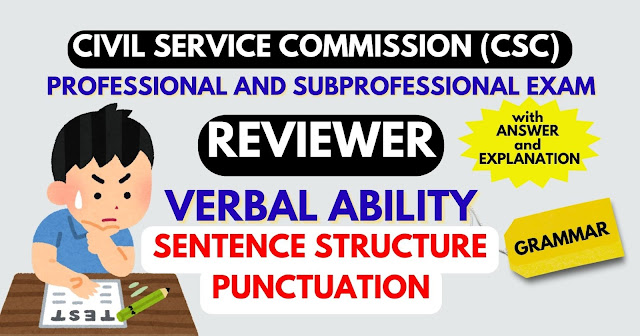The Civil Service Professional and Sub-Professional Eligibility Examinations in the Philippines are crucial assessments for individuals aspiring to work in government positions. A significant component of these examinations is the Verbal Ability Test, which evaluates the examinee's proficiency in English language skills. This test is essential as effective communication is vital for public service roles. The Verbal Ability Test primarily focuses on two key areas: Sentence Structure and Punctuation.
Importance of Verbal Ability in Civil Service Examinations
Verbal Ability is a fundamental aspect of the Civil Service Exams because government employees must communicate clearly and effectively. Proficiency in English ensures that official documents, reports, and communications are correctly understood and conveyed. The Verbal Ability Test assesses the candidate's ability to comprehend and construct grammatically correct sentences, an essential skill in drafting memos, emails, and other official correspondence.
Components of the Verbal Ability Test
1. Sentence Structure
Sentence structure is the backbone of clear communication. It involves understanding how words and phrases are organized to form sentences that are grammatically correct and convey the intended meaning. The examination tests various aspects of sentence structure, including:
- Subject-Verb Agreement: Ensuring that subjects and verbs agree in number (singular or plural). For example, "The dog barks" is correct, while "The dog bark" is incorrect.
- Proper Use of Tenses: Using the correct tense to indicate the timing of actions. For example, "She will attend the meeting" (future tense) versus "She attended the meeting" (past tense).
- Sentence Variety: Employing a mix of simple, compound, and complex sentences to enhance clarity and readability.
- Modifiers: Placing adjectives, adverbs, and phrases correctly to modify the right words. Misplaced modifiers can lead to confusing sentences.
- Parallelism: Using the same grammatical structure in related words, phrases, or clauses. For example, "She likes hiking, swimming, and biking" is parallel, while "She likes hiking, swimming, and to bike" is not.
2. Punctuation
Punctuation marks are essential for clarifying meaning in written text. Proper punctuation helps to convey the correct meaning and ensures that the text is easy to read. The examination assesses the candidate's knowledge of various punctuation marks and their correct usage, including:
- Commas (,): Used to separate items in a list, after introductory elements, to set off nonessential clauses, and to separate independent clauses joined by conjunctions. For example, "We visited Paris, London, and Rome" or "After the show, we went out for dinner."
- Periods (.): Indicate the end of a declarative sentence. For example, "She completed her assignment."
- Question Marks (?): Used at the end of direct questions. For example, "What time is the meeting?"
- Exclamation Points (!): Express strong emotion or emphasis. For example, "Watch out!"
- Colons (:) and Semicolons (;): Colons are used to introduce lists or explanations, while semicolons connect closely related independent clauses. For example, "He had one hobby: painting" and "She loves to read; her favorite book is 'Pride and Prejudice.'"
- Quotation Marks (“ ”): Enclose direct speech or quotations. For example, "She said, 'I'll be there soon.'"
- Apostrophes (’): Indicate possession or form contractions. For example, "Sarah's book" or "It's a sunny day."
Relation to the Civil Service Examination
The Verbal Ability Test in the Civil Service Examination ensures that candidates possess the necessary language skills to perform effectively in their roles. Government positions often require the creation and interpretation of written materials, making strong verbal skills essential. For both the Professional and Sub-Professional levels, the test assesses the candidate's ability to write clearly, avoid ambiguities, and adhere to the rules of English grammar and punctuation.
Preparation Tips
- Practice Regularly: Consistent practice with sample questions and past papers can help improve sentence structure and punctuation skills.
- Read Extensively: Reading books, articles, and official documents can enhance understanding and application of proper sentence construction and punctuation.
- Seek Feedback: Writing practice essays and seeking feedback from mentors or peers can identify areas needing improvement.
- Study Guides: Utilize study guides and online resources tailored for the Civil Service Exam.

